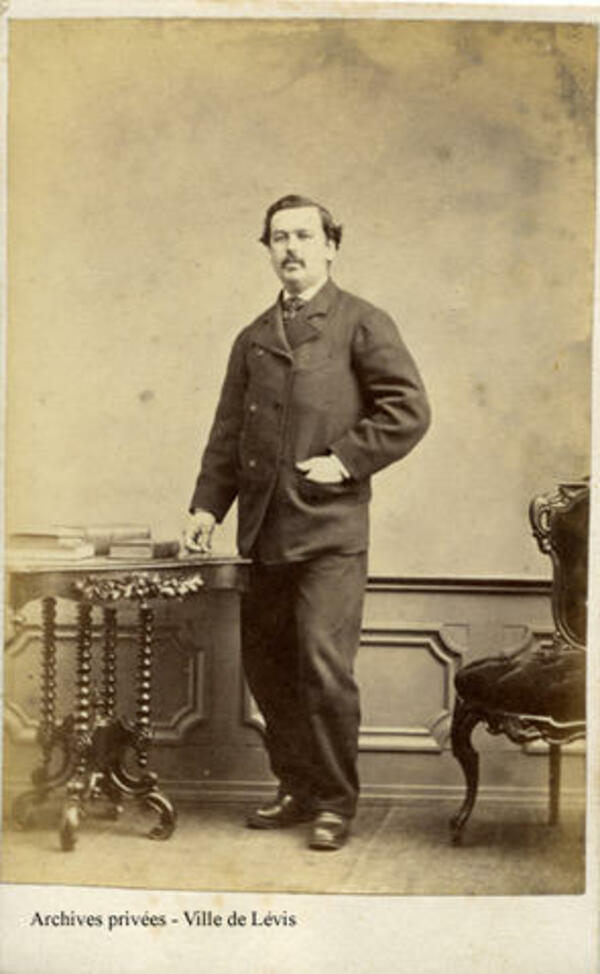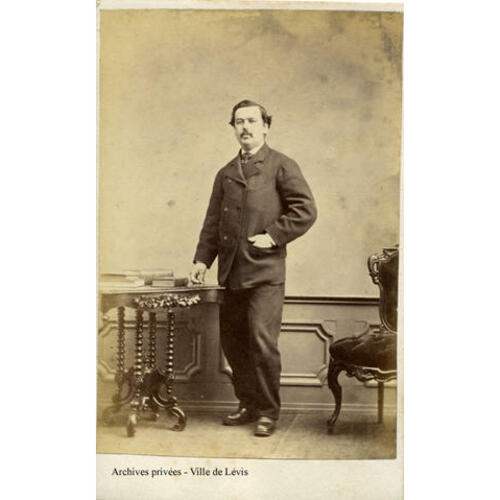
Source: Link
CARRIER, CHARLES WILLIAM (baptized Charles-Guillaume), businessman; b. 20 Jan. 1839 at Saint-Henri, Lower Canada, son of Ignace Carrier and Marie-Louise Dallaire; m. 1 June 1864 Henriette, daughter of Louis Carrier, merchant and mayor of Lévis, Canada East; d. 18 Sept. 1887 at Lévis.
The youngest of a family of 14 children, Charles William Carrier entered the Collège de Lévis in 1853, the year of its opening [see Joseph-David Déziel]. In 1855 he commenced an apprenticeship in the local commercial firm of Louis Carrier, his future father-in-law. There he was given full rein to learn business practices. In 1861 he took over the management of the firm, and, following his marriage in 1864, he was given complete control. Successful in this endeavour, he was able that same year to accept the proposal of a young mechanic, Damase Lebon, dit Laîné, to establish an iron foundry at Lévis. It was a major venture for these years. Wooden shipbuilding had been given a temporary stimulus by the American Civil War just at the time it had started to give way to iron shipbuilding in the rest of the world. The boom years of 1862 and 1863 for wooden ships therefore concealed the reality that their days were numbered. Carrier and Laîné saw beyond this activity and realized the need for the establishment of competent iron works, manufacturing a variety of products such as steam pumps, engines, and boilers. With this purpose in mind, in 1864 they formed the Fonderie Canadienne at Lévis, which was managed by the firm of D. Laîné et Compagnie. Six years later, with the acceptance of a third associate, Pierre-Sévère Riverin, the original partnership was dissolved and replaced by the firm of Carrier, Laîné et Compagnie. According to Le Canadien of 4 Nov. 1872, the foundry, which occupied 13,000 square feet near the Quebec-Lévis ferry landing and already employed over 100 workers, was busily expanding its operations. In addition to manufacturing domestic commodities, such as stoves, and mechanical instruments, the company had ventured into shipbuilding on a small scale, constructing barges and river ferries.
By 1873, Carrier, Laîné et Compagnie was soundly established and justifiably well known, and in that year steps were taken to incorporate it as the Quebec Iron Works. A prospectus was issued on 22 May proposing a joint stock company with a capitalization of $100,000. There were some extraordinary clauses in this prospectus, not the least of which were a personal guarantee from the promoters for three years of an 8 per cent annual dividend for shareholders and a rapid schedule for the calling of shares. The company proposed refitting its workshops to meet the construction needs of the rapidly developing railway system around Quebec, and planned to begin the manufacture of more sophisticated products such as wheels, axles, and ancillary equipment for railway rolling-stock. Capitalists may have had doubts about the future of railway development – this was the year of the Pacific Scandal – or about the ability of the partners to cope with such a large-scale undertaking; in any case, the idea seems to have died. No evidence has been found that the Legislative Assembly of the province of Quebec was approached for an act of incorporation. None the less, by 1880 Carrier, Laîné et Compagnie had added a new building to their works, measuring 200 feet by 80 feet, for the manufacture of locomotive and other types of engines. The following year the company signed a contract with the Intercolonial Railway for the construction of 100 railway cars.
Carrier was an employer of the old stamp who took a paternal interest in his workmen. He was credited with rejuvenating Lévis just when the shipyards were starting their decline, and he established training programmes for his employees in the skills of ironworking. To this end he had brought over from Europe French and Belgian specialists abreast of the latest technological innovations in metallurgy. He also did everything in his power to obtain the best possible environment for his firm, and became involved in the formation of various societies for the advancement of local industry: he was one of the founders of the Permanent Building Society of Lévis in 1869, president of the Board of Trade of the town of Lévis in 1873, director of the Société de prêts et de placements de Québec in 1878, and president of the Board of Arts and Manufactures of the province of Quebec from 1882 to 1887. This board, created in 1857, was charged with the establishment of technical schools in the principal industrial centres of the province; as a result of Carrier’s influence, Lévis was granted a technical school in 1873. He also supported other projects affecting his community; in 1877, for example, he was listed among the shareholders of the Levis and Kennebec Railway Company [see Louis-Napoléon Larochelle] and, in 1881, among those of the Quebec and Levis Telephone Company. Constantly on the look-out for new projects, he became one of the administrators of the North Shore Railway Company in 1882.
In 1886 Carrier contracted tuberculosis, and in the winter of 1886–87 he left for California to seek a cure. His journey was to no avail, and he returned to Lévis to die. As befitting one who had given so much to his community, Carrier was accorded “one of the most largely attended” funerals ever seen at Lévis. People of all classes of society came to pay homage to the man who had kept the city prosperous and busy throughout the 1870s and early 1880s while other towns suffered depression and unemployment. Of Carrier’s three sons, only Charles-Henri continued his father’s interest in the foundry; finally, in 1908, Carrier, Laîné et Compagnie was sold to the Bank of Montreal for $380,000.
ANQ-Q, État civil, Catholiques, Notre-Dame (Lévis), 1er juin 1864; Saint-Henri, 21 janv. 1839. Baker Library, R. G. Dun & Co. credit ledger, Canada, 8. Le Canadien, 4 nov. 1872. Morning Chronicle (Quebec), 27 May 1873. Cyclopædia of Canadian biog. (Rose, 1888). P.-G. Roy, Dates lévisiennes (12v., Lévis, Qué., 1932–40), I–III. Gervais, “L’expansion du réseau ferroviaire québécois.” P.-G. Roy, “Un industriel canadien-français: Charles-William Carrier,” Cahiers des Dix, 13 (1948): 187–223.
Cite This Article
Kenneth S. Mackenzie, “CARRIER, CHARLES WILLIAM (baptized Charles-Guillaume),” in Dictionary of Canadian Biography, vol. 11, University of Toronto/Université Laval, 2003–, accessed January 12, 2026, https://www.biographi.ca/en/bio/carrier_charles_william_11E.html.
The citation above shows the format for footnotes and endnotes according to the Chicago manual of style (16th edition). Information to be used in other citation formats:
| Permalink: | https://www.biographi.ca/en/bio/carrier_charles_william_11E.html |
| Author of Article: | Kenneth S. Mackenzie |
| Title of Article: | CARRIER, CHARLES WILLIAM (baptized Charles-Guillaume) |
| Publication Name: | Dictionary of Canadian Biography, vol. 11 |
| Publisher: | University of Toronto/Université Laval |
| Year of publication: | 1982 |
| Year of revision: | 1982 |
| Access Date: | January 12, 2026 |



